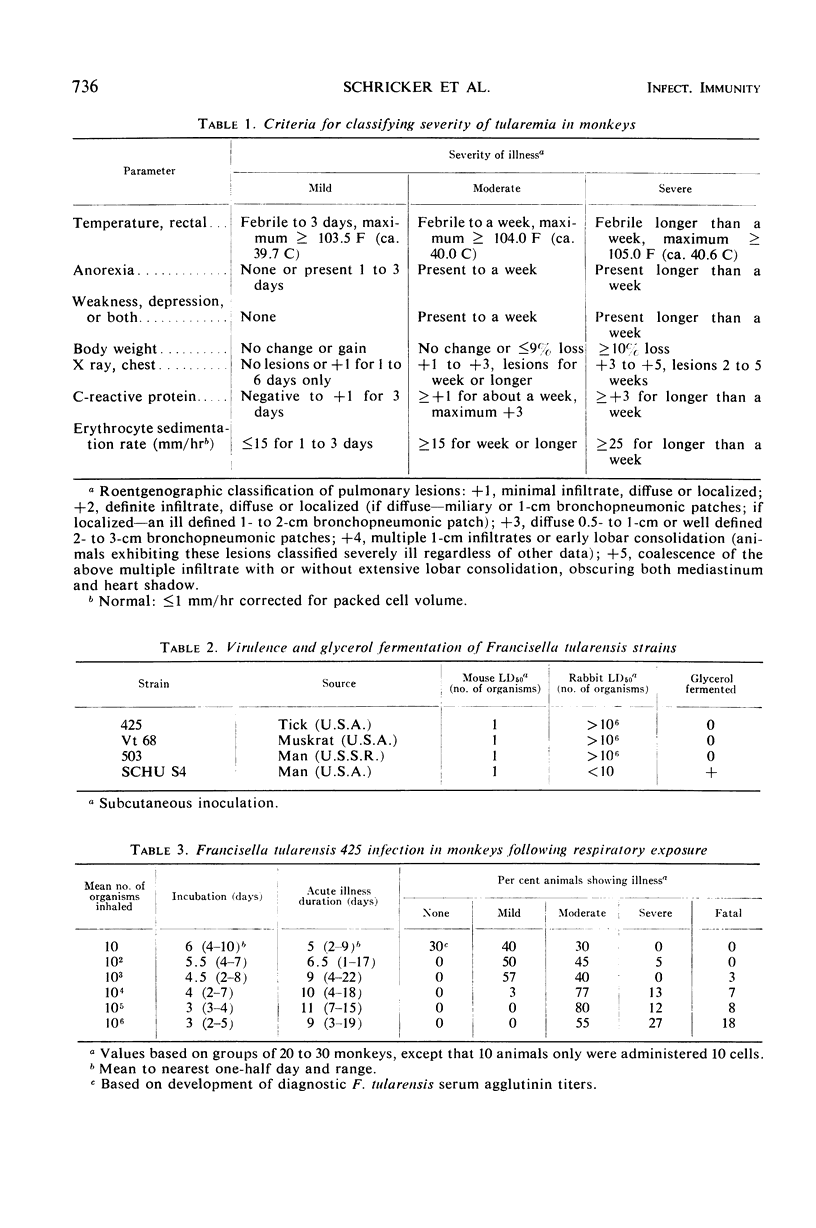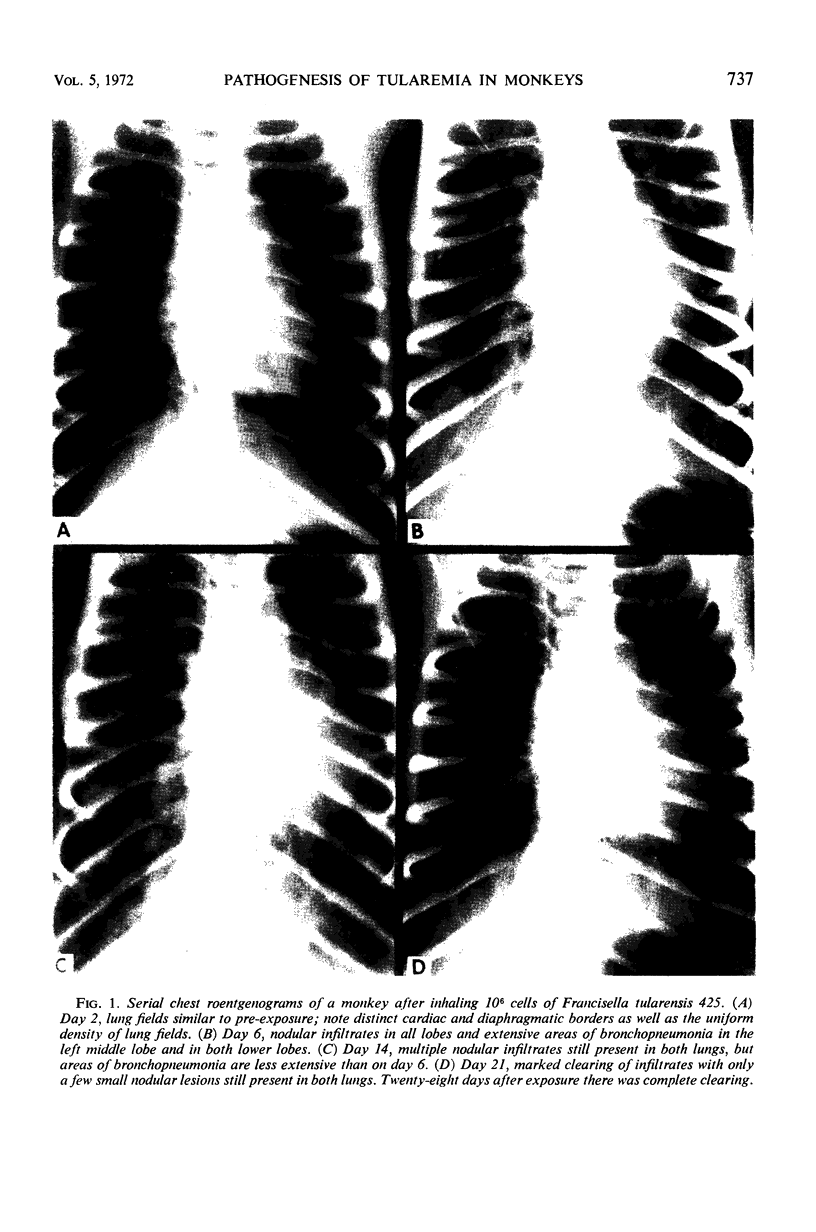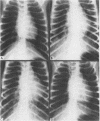Abstract
The pathogenesis of tularemia was studied in groups of rhesus monkeys (Macaca mulatta) that inhaled graded 10-fold doses ranging from 10 through 106 organisms of Francisella tularensis 425, a strain highly virulent for the white mouse but of reduced virulence for the domestic rabbit. Mean incubation periods ranged from 3 to 6 days followed by acute illness lasting 5 to 11 days with subsequent recovery of most animals. The higher inhaled doses resulted in shorter incubation periods, longer and more severe acute illnesses, and 18% mortality at the highest dose. Strain 425 multiplied in the lungs, disseminated to the regional lymph nodes, and became systemic. Maximal bacterial populations in tissues were reached by the 7th day after exposure of the animals regardless of the number of organisms inhaled. F. tularensis was no longer recoverable from any of six tissues examined 2 months after exposure. The most significant tissue changes occurred in the lungs; these consisted of foci of liquefaction necrosis, lobular consolidation, and pleural effusion and adhesions. The data indicate that the inhaled dose of strain 425 determined the maximal growth of the organism in the lungs which in turn influenced the severity of the usually self-limiting pneumonia and systemic infection. Although the monkey is less resistant to tularemia than is man, this laboratory animal when infected with F. tularensis 425 provides a useful model for the self-limiting type of human pulmonary tularemia usually observed in Europe and Asia but to a lesser extent in North America.
Full text
PDF










Images in this article
Selected References
These references are in PubMed. This may not be the complete list of references from this article.
- BELL J. F., OWEN C. R., LARSON C. L. Virulence of Bacterium tularense. I. A study of the virulence of Bacterium tularense in mice, guinea pigs, and rabbits. J Infect Dis. 1955 Sep-Oct;97(2):162–166. doi: 10.1093/infdis/97.2.162. [DOI] [PubMed] [Google Scholar]
- Brooks G. F., Buchanan T. M. Tularemia in the United States: epidemiologic aspects in the 1960s and follow-up of the outbreak of tularemia in Vermont. J Infect Dis. 1970 Mar;121(3):357–359. doi: 10.1093/infdis/121.3.357. [DOI] [PubMed] [Google Scholar]
- EIGELSBACH H. T., BRAUN W., HERRING R. D. Studies on the variation of Bacterium tularense. J Bacteriol. 1951 May;61(5):557–569. doi: 10.1128/jb.61.5.557-569.1951. [DOI] [PMC free article] [PubMed] [Google Scholar]
- EIGELSBACH H. T., DOWNS C. M. Prophylactic effectiveness of live and killed tularemia vaccines. I. Production of vaccine and evaluation in the white mouse and guinea pig. J Immunol. 1961 Oct;87:415–425. [PubMed] [Google Scholar]
- Eigelsbach H. T., Tulis J. J., McGavran M. H., White J. D. LIVE TULAREMIA VACCINE I. : Host-Parasite Relationship in Monkeys Vaccinated Intracutaneously or Aerogenically. J Bacteriol. 1962 Nov;84(5):1020–1027. doi: 10.1128/jb.84.5.1020-1027.1962. [DOI] [PMC free article] [PubMed] [Google Scholar]
- Hornick R. B., Eigelsbach H. T. Aerogenic immunization of man with live Tularemia vaccine. Bacteriol Rev. 1966 Sep;30(3):532–538. doi: 10.1128/br.30.3.532-538.1966. [DOI] [PMC free article] [PubMed] [Google Scholar]
- Hornick R. B., Eigelsbach H. T. Tularemia epidemic--Vermont, 1968. N Engl J Med. 1969 Dec 4;281(23):1310–1310. doi: 10.1056/NEJM196912042812325. [DOI] [PubMed] [Google Scholar]
- McGavran M. H., White J. D., Eigelsbach H. T., Kerpsack R. W. Morphologic and Immunohistochemical Studies of the Pathogenesis of Infection and Antibody Formation Subsequent to Vaccination of Macaca irus with an Attenuated Strain of Pasteurella tularensis: I. Intracutaneous Vaccination. Am J Pathol. 1962 Sep;41(3):259–271. [PMC free article] [PubMed] [Google Scholar]
- OLSUFYEV N. G., EMELYANOVA O. S. Further studies of strains of tularaemic bacteria of the old and new world. J Hyg Epidemiol Microbiol Immunol. 1962;6:193–205. [PubMed] [Google Scholar]
- OVERHOLT E. L., TIGERTT W. D. Roentgenographic manifestations of pulmonary tularemia. Radiology. 1960 May;74:758–765. doi: 10.1148/74.5.758. [DOI] [PubMed] [Google Scholar]
- OWEN C. R., BUKER E. O., JELLISON W. L., LACKMAN D. B., BELL J. F. COMPARATIVE STUDIES OF FRANCISELLA TULARENSIS AND FRANCISELLA NOVICIDA. J Bacteriol. 1964 Mar;87:676–683. doi: 10.1128/jb.87.3.676-683.1964. [DOI] [PMC free article] [PubMed] [Google Scholar]
- SASLAW S., EIGELSBACH H. T., PRIOR J. A., WILSON H. E., CARHART S. Tularemia vaccine study. II. Respiratory challenge. Arch Intern Med. 1961 May;107:702–714. doi: 10.1001/archinte.1961.03620050068007. [DOI] [PubMed] [Google Scholar]
- SASLAW S., EIGELSBACH H. T., WILSON H. E., PRIOR J. A., CARHART S. Tularemia vaccine study. I. Intracutaneous challenge. Arch Intern Med. 1961 May;107:689–701. doi: 10.1001/archinte.1961.03620050055006. [DOI] [PubMed] [Google Scholar]
- Sawyer W. D., Dangerfield H. G., Hogge A. L., Crozier D. Antibiotic prophylaxis and therapy of airborne tularemia. Bacteriol Rev. 1966 Sep;30(3):542–550. doi: 10.1128/br.30.3.542-550.1966. [DOI] [PMC free article] [PubMed] [Google Scholar]
- Tulis J. J., Eigelsbach H. T., Kerpsack R. W. Host-parasite relationship in monkeys administered live tularemia vaccine. Am J Pathol. 1970 Feb;58(2):329–336. [PMC free article] [PubMed] [Google Scholar]
- WHITE J. D., ROONEY J. R., PRICKETT P. A., DERRENBACHER E. B., BEARD C. W., GRIFFITH W. R. PATHOGENESIS OF EXPERIMENTAL RESPIRATORY TULAREMIA IN MONKEYS. J Infect Dis. 1964 Jun;114:277–283. doi: 10.1093/infdis/114.3.277. [DOI] [PubMed] [Google Scholar]
- White J. D., McGavran M. H., Prickett P. A., Tulis J. J., Eigelsbach H. T. Morphologic and Immunohistochemical Studies of the Pathogenesis of Infection and Antibody Formation Subsequent to Vaccination of Macaca irus With an Attenuated Strain of Pasteurella tularensis: II. Aerogenic Vaccination. Am J Pathol. 1962 Oct;41(4):405–413. [PMC free article] [PubMed] [Google Scholar]
- Young L. S., Bickness D. S., Archer B. G., Clinton J. M., Leavens L. J., Feeley J. C., Brachman P. S. Tularemia epidemia: Vermont, 1968. Forty-seven cases linked to contact with muskrats. N Engl J Med. 1969 Jun 5;280(23):1253–1260. doi: 10.1056/NEJM196906052802301. [DOI] [PubMed] [Google Scholar]



